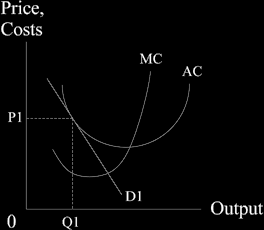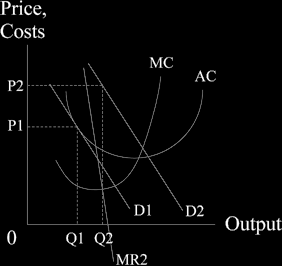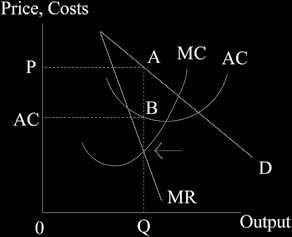| Home | Revision | A-Level | Economics | Theory of Production & Costs | Imperfect competition or.. |
Imperfect competition or monopolistic competition
(The bit in the middle!)
What is monopolistic competition?
It is defined as a situation where there are:
Many buyers and sellers of that type of good or service (= “competition”). Free entry and exit (= “competition”).
But each with its own brand of the good or service (= “monopoly” on the brand name).
So each faces a downward sloping demand curve for its branded product (= a monopoly on the brand name).
Notice the mixed elements of both monopoly and competition, hence the name
“monopolistic competition”. You know it makes sense!
Where is the long-run equilibrium position?
At the tangent of the demand curve and the average cost curve, as in the diagram below.

Q. Why is equilibrium tangential?
A. Because of the assumptions of strong competition.
If the firm improves the product, e.g. suddenly changes the colour to a currently fashionable one, the demand for the product will increase from D1 to D2 in the diagram below. This allows the price to increase to P2 and more units are sold (OQ2) and hence higher profits are made in the firm.
Why is the new price at P2?
We read off the new equilibrium position from the intersection of the marginal revenue curve (MR2), (which relates to the new demand curve D2) with the marginal cost curve (MC). This intersection determines the quantity that it is most profitable to produce, which is OQ2. Then we just go straight up and read the price the firm will set from the new demand curve. Why from this curve? Because the demand curve is the curve that relates price to quantity, you will remember, and we have just determined the quantity.

The firm is then getting monopoly profits – and the equilibrium diagram to reveal these is the same as the standard monopoly diagram. The profits are the area P A B AC in the diagram below.

But these monopoly profits can occur in the short term only!
The higher profits and visibly higher price draw the attention of competitors who can compete by colouring their product also!
The demand for the original product then falls back.
Q. How far does it fall?
A. Until the monopoly profits are eroded to zero when competitors stop coming in! So in long run there can be no monopoly profits – the equilibrium position is always
tangential!
NOTE the price in equilibrium: it is on the average cost curve but is above the marginal cost curve. (Multiple choice questions might ask about this!)
Problems with monopolistic competition
There are wastes of time and effort – the firm will worry about the actions of competitors.
There are wastes of resources, for some are underused. You can see this because where we are operating is not at the bottom of the average cost curve and excess capacity exists.
There may be too much product differentiation; the firm may pretend its product is “better” but it may merely be different.
There are the wastes of advertising.
There may be other promotional wastes, like free gifts, 2-for-1 offers, or competitions to get a trip to Spain etc. instead of lower prices or better quality. Running such schemes does use real resources.
The benefits of monopolistic competition
It is very competitive – the firms watch their competitors very closely.
This competition drives firms along and there is strong endeavour to improve quality and design, as well as to lower price.
Free entry and exit keeps the level of competition up.
Variety is great, there is more choice and hence, we assume, greater consumer satisfaction. Some however argue that there may be too much choice which can confuse and irritate people rather than help them.
On balance, there is a lot of monopolistic competition in the real world; some argue it is the mainspring that drives the economy forward by producing new goods, cheaper goods, better goods - or at least different ones.